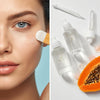
Peels & exfoliation – for smooth, radiant skin
4 min reading time

4 min reading time
Discover the power of peels and exfoliation. Learn how acids and enzymes renew, brighten, and brighten your skin—safely and professionally.
Peels & exfoliation – the secret to smooth, radiant skin
Healthy, glowing skin doesn't happen by chance – it's the result of regular renewal and removal of dead skin cells.
Peels and exfoliation are key to that natural glow, but are often misapplied or misunderstood.
The experts at Diana Beauty & PRO HAAR explain how exfoliation works, what types of peels exist, and how to safely integrate them into your routine for maximum results.
Why exfoliation is so important
The skin naturally renews itself every 28 to 35 days. With age and due to external factors (stress, sun, cold, pollution), this process slows down. Dead skin cells cling to the surface, making the skin look dull, uneven, and tired.
Regular exfoliation:
✔ Removes dead skin cells and promotes cell renewal.
✔ Brightens the complexion and reduces pigment spots.
✔ Refines pores and improves texture.
✔ Improves absorption of active ingredients.
✔ Stimulates collagen production with long-term use.
A well-performed peel transforms the skin – softer, smoother and visibly more youthful.
Types of exfoliation – physical and chemical
There are two main types of exfoliation, each with their own benefits:
✔ Physical exfoliation (mechanical): uses fine granules or enzymes that massage away dead cells.
• Suitable for normal and oily skin.
• Use max. 1–2× per week.
• Avoid scrubs that are too coarse – they can cause micro-damage.
✔ Chemical exfoliation: works without friction, using acids that dissolve bonds between dead cells.
• AHA acids (such as glycolic acid, lactic acid) – ideal for dry or dull skin.
• BHA acids (such as salicylic acid) – penetrate deep into pores, perfect for oily or acne-prone skin.
• PHA acids – mildest option, suitable for sensitive skin.
Chemical peels are more modern and effective – they work deeper, without abrasion.
Pro tip: Never combine multiple acids at once without getting used to them. Start with one product, 2–3 times a week, and increase as you develop your tolerance.
How to apply exfoliation correctly
🌞 Morning or evening?
It is best to use AHAs and BHAs in the evening – acids can make the skin slightly sensitive to the sun.
🌙 Preparation: Cleanse the skin with a mild cleanser, dry gently.
💧 Application: Apply the exfoliating product with a cotton pad or clean fingers. Avoid the eyes and lips.
🧴 Aftercare: Moisturize generously and always use SPF 30+ the next day.
Common mistakes with peels
❌ Exfoliating too often – damages the skin barrier.
❌ Using scrubs for acne – spreads bacteria.
❌ Combine acids with retinol or pure vitamin C.
❌ Do not use sun protection after peeling.
❌ Thinking that “more injections = better results.”
Solution: gentle, consistent, and with skin awareness. Skin needs time to renew itself—respect that rhythm.
Exfoliation by skin type
✔ Dry skin: lactic acid or PHA – gentle and hydrating.
✔ Oily skin: salicylic acid or enzymatic peeling.
✔ Sensitive skin: enzymatic exfoliation or PHA.
✔ Dull skin: glycolic acid for extra glow.
✔ Mature skin: combination of lactic acid + peptides for smoothness and firmness.
Pro tip: Exfoliate less often in winter (1–2x per week) and increase to 3x per week in spring/summer for well-tolerated skin.
Natural exfoliants – gentle yet effective
For those who love natural skincare, there are plant-based alternatives:
✔ Enzymes from papaya, pineapple or pumpkin – gently remove dead cells.
✔ Lactic acid from fermented milk – mild moisturizing effect.
✔ Mandelic acid – refines texture without irritation.
These options are perfect for sensitive or thin skin.
Conclusion – exfoliation is renewal, not aggression
A peeling is not a punishment for your skin, but an invitation to renewal.
When done correctly, exfoliation becomes the secret weapon for smooth, fresh, and youthful skin.